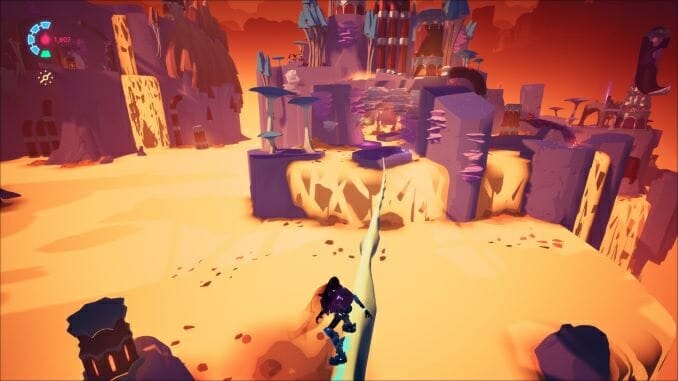Solar Ash: Rollin’ Around at the Speed of Sound

Solar Ash finds itself in the unenviable position of following up Hyper Light Drifter, one of the best games in recent memory. Despite an occasionally similar color palette and ethereal, dilapidated world design, Solar Ash stands tall to Heart Machine’s last hit thanks it part to its smart level design and understanding of speed and movement.
Your playground is a doomed world slowly disappearing into a black hole. Rei, the protagonist, recognizes the gravity of the situation, but not the challenge—she’s dwarfed by the scale and design of the world and the odds stacked against her. She glides on, determined to save her planet from the unbreakable hold of a world-eating black hole.
Solar Ash’s world design and art bolster its cosmic premise. Fluffy clouds loom over the remnants of the places that were. Some areas feature the wreckage of a fallen imperialistic civilization, complete with vast reflection pools and grandiose architecture. Others are former cityscapes or dark forests. All are twisted by the approaching black hole, contorted by its unbreakable pull.
Despite the game’s cohesive visual design, each area has a distinct feel to it. That’s due in part to the unique setting of the world, but also is a result of each area’s distinct mechanics. Since none of the game’s individual mechanics are particularly deep, these small changes help keep the game from growing stale. This is also really helpful since the game’s structure relies so heavily on repetition.
After a brief prologue explains just how dire the straits are for Rei, she’s immediately thrown into the void; the game’s name for the supermassive black hole. The tutorial feels wrong, but it does what only the best open games do: it puts players through a series of smaller rooms for a few minutes, ending in a long corridor, only to open up into the game’s vast hub.
It’s an effortlessly satisfying moment to delay the gratification that comes with exploring an open space, even if only for a moment. Is it also a cheap trick? Perhaps, but Solar Ash justifies the decision. Movement is at the core of Solar Ash’s gameplay loop, and it flaunts that here. As you hold one button down to glide at high speeds, moving from smaller, more linear spaces to a wide field of clouds feels freeing and exciting.
Beyond that, even just the simple act of gliding feels great. Sitting at the core of nearly everything you do in Solar Ash, gliding functions as both a means of traversal and a gameplay mechanic. It allows you to build up just the right momentum to perform a tricky jump or zoom over to an objective in one of the game’s platforming challenges.
Of course, a mechanic can’t just feel good; it has to be utilized well within the game or else the total package will make for a disappointing experience. This is where Solar Ash’s world design becomes deeply important. Speed is important to the feel of the character in any number of Sonic games, or any game that heavily relies on speed and momentum, but that’s not always reflected in the level design.
-

-

-

-

-

-

-

-

-

-

-

-

-

-

-

-

-

-

-

-

-

-

-

-

-

-

-

-

-

-

-

-

-

-

-

-

-

-

-

-








































